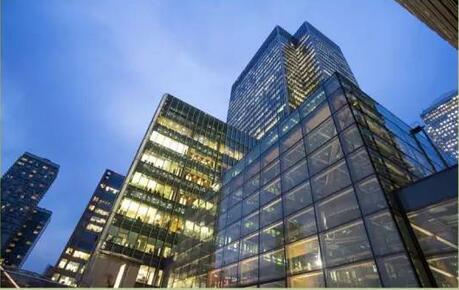光伏建筑一体化在中国的潜力
作者:[德]施维德 博士 (斯图加特大学、设能建筑咨询(上海)有限公司)
Author: Dr. Dirk Schwede (Stuttgart University, energydesign (Shanghai) Co., Ltd.)
Email: dirk.schwede@energydesign-asia.com
来源:可持续建筑能力中心
下文节选自2017年econet monitor绿色建筑特刊,第26-27页。
The following text is excerpted from the Econet Monitor Special 2017, page 26-27.
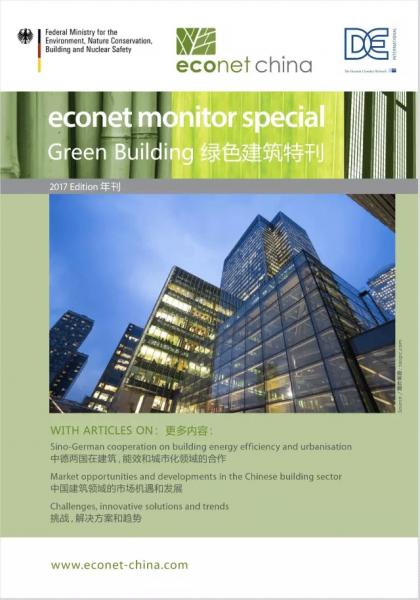
相对于德国的单一气候,中国的一些地区更容易达到用能需求和光伏产能之间的平衡。因此,我们对中国26个城市(图1)进行了研究,以确定各地的具体能源需求以及屋顶光伏建筑一体化系统潜在的产能量。根据各地的能源需求特征,我们对不同气候区域的建筑节能改造策略进行了深化。基于德国家庭目前的生活标准我们计算出了这26个城市的家庭能源需求量。研究中设定中国家庭配备的家用电器和德国相似,并且所有家电都是中国市场上可购买到的最高能效等级(等级一)。
While Germany’s climate is rather uniform, there are places in China where the energy demand and the energy production from a PV system is easier to be balanced than in other places. Therefore, an investigation of 26 locations in China (fig.1) has been conducted in order to determine specific energy demand profiles at the sites and the potential output of roof-integrated PV systems. Based on energy demand profiles, strategies adapted to different climate zones for energy saving have been developed. The energy demand for a modern lifestyle has been calculated, based on current household demand in Germany. It has been assumed that households in China are equipped with appliances similar to Germany and that all appliances are of the highest Chinese energy-efficiency class (level1).
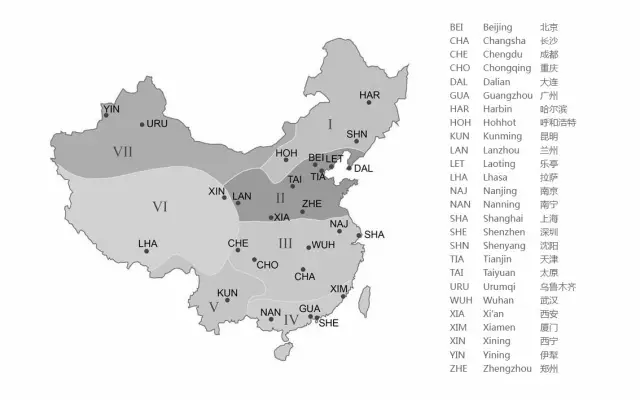
图1 研究中涉及的中国不同热工气候分区下的26个城市
fig.1 26 locations in all building climate zones in China for the investigation
每个城市南向光伏板在不同倾角下的系统输出都得到了计算(图2)。结果显示光伏系统在大部分城市的产出均比德国斯图加特高。这归因于更长的日照时间和更高的太阳高度角(纬度更低并且更稳定的太阳路径)。其中光伏系统在拉萨的产出最多,因为拉萨海拔高,天空能见度高并且晴朗。广州光伏系统的产出最少,其原因归咎于较高的空气湿度和普遍的云层覆盖造成的大量漫反射。总体上来说,相较于制冷与除湿为主要需求的气候区域,光伏系统更适合于以供暖为主要需求的气候区域。此外,就研究中涉及的所有城市而言,太阳能光伏板朝南并且有15度倾斜角时能够获得最大的系统产出。
The output of the PV systems has been calculated for each location for various system slopes for south orientation (fig.2). In most locations a higher output can be realized than in Stuttgart, Germany. This is due to longer daylight hours with higher solar inclination (a steadier sun path at low latitudes). The highest solar output can be achieved in Lhasa due to high altitude and its clear and sunny climate. Lowest PV output is achieved in Guangzhou, where the major part of the radiation is diffuse due to high humidity levels in the air and the prevailing cloud cover. In summary, heating climates are more suitable for PV power generation than climates with cooling and dehumidification demand. For all locations, a PV system with 15°-slope towards the south performs best.
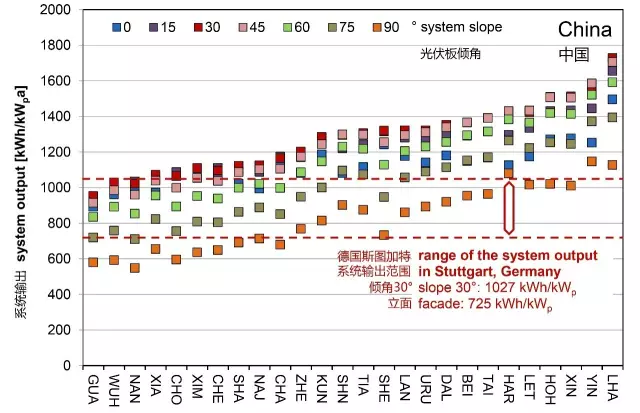
图2 中国26个城市不同倾角的屋顶光伏建筑一体化系统的太阳能系统输出
fig.2 Solar systems output of a roof integrated PV system with various roof slopes in 26 locations in China
另外,研究中不同地区采用了不同的建筑节能改造方法,比如北方需要增加保温层厚度,并使用三层玻璃,而南方则采用厚度适中的保温层,并使用双层防晒玻璃。而针对所有地区,建筑均被设定为围护结构具有较高的气密性,在使用空调的情况下采用机械通风,在过渡季节舒适的气候条件下通过窗户的开启自然通风。在中国北部和西部地区,建筑的通风系统配备热回收功能,在南部和东部地区,通风系统则配备热和湿回收功能。供暖与制冷均采用最高能效级别的分散式系统。
On the other hand, the energy saving concepts are characteristic for the specific location with, for example, increased insulation thickness and 3-pane glazing in the North and moderate insulation thickness and 2-pane sun protection glazing in the South. In all climates building concepts include an airtight building envelope and a mechanical ventilation system for times of conditioning demand and natural ventilation through operable windows in time with moderate outdoor conditions. Ventilation systems are equipped with heat recovery functions in the North andin the West, and heat and moisture recovery in the South and the East. Heating and cooling is generated with decentralized systems of the highest efficiency class.
我们对能源消耗(供暖、制冷、照明、热水、辅助用能和家用电器)所对应的二氧化碳减排量和光伏系统输出对应的二氧化碳减排量进行了分析(图3)。结果显示在所有气候条件下三层楼建筑能实现碳中和,而六层楼建筑二氧化碳能够实现50%的减排。在不考虑家用电器带来的能源需求的情况下,六层楼建筑也能实现年度碳中和。
The energy figures are evaluated with CO₂ emissions for the local energy mix (fig.3). Balancing the CO₂ emissions from energy consumption (heating, cooling, lighting, hot water, auxiliary energy and appliances) and the CO₂ benefits from PV output, in all climates 3-storey buildings can be carbon-neutral and in 6-storey buildings the CO₂ emissions can be off-set by 50%. If the energy demand for appliances is not included 6-storey buildings can be carbon-neutral in their annual balance.
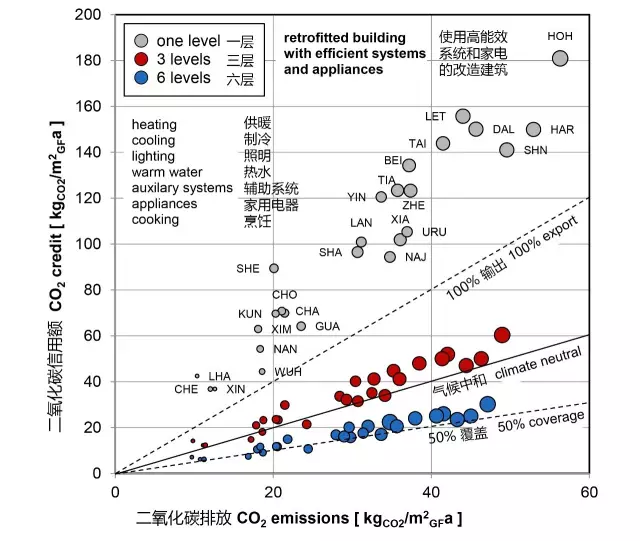
图3(节能改造后)一层、三层和六层建筑能源消耗对应的二氧化碳排放量和采用光伏建筑一体化系统获得的二氧化碳信用额
fig.3 CO₂ emissions and CO₂ credits for buildings with one, three, and six levels (after energy retrofit)
研究表明光伏建筑一体化可以在中国所有地区以及相关气候条件下对既有建筑的低碳改造起到重要作用。就中国典型的旧城区五到七层的住宅建筑而言,必要的节能改造结合屋顶光伏建筑一体化系统能够使既有建筑达到接近碳中和的标准(建筑本身不需要额外的能源供给)。
This investigation shows that BIPV can contribute significantly to a low carbon building stock in all parts of China and under all relevant climatic conditions. Considering typical residential apartment compounds with 5-7 storeys, the necessary energy upgrade combined with PV applications on the roof could result in a nearly carbon neutral building stock (building energy demand without energy use).
研究证明中国多层住宅在节能改造后的能源需求和能源产出可以达到平衡,下一步还需要政策的支持,充分面向未来的投资,优秀的工程设计和建造工艺,这样中国城市低碳建筑的潜力才能够真正实现。
As it has been shown that the energy demand and the energy generation can be balanced, a supportive political framework, sufficient future-oriented investment, good engineering and craftsmanship is needed to realise these potentials for low-carbon-buildings in China’s cities.
作者: 来源:可持续建筑能力中心 责任编辑:wutongyufg
